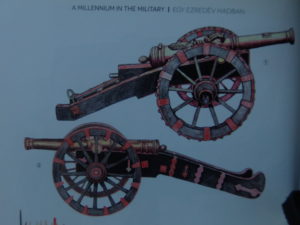Andrew Gaudi, the Scot hero of Várad
13 September 1658: the siege of Várad has begun; its hero was a Scot officer, Andrew aka András Gaudi / Gawdy.

Gaudi was an artillery officer of Scottish descent. According to the sources his name was Andrew Gawdy and he was born in 1612 or 1613. We do not know exactly when he appeared in the service of Prince Rákóczi, but he was among his soldiers already at the beginning of 1637, because he was the envoy of Rákóczi who sent him to Poland. He also participated in the forging of the alliance between the Transylvanian prince and the Protestant powers.

He had fought successfully in the 1644-45 campaign of Prince Rákóczi György I of Transylvania against King Ferdinand III of Habsburg, as one of the leaders of Rákóczi’s army. (Please note that I am using the Oriental name order for Hungarians, where surnames come first). We know that he and Kemény János besieged the castle of Szatmár in February 1644. Gaudi was in charge of 250 German musketmen. He also took part in the capture of Lőcse (Levoca), and then he went to serve the Swedes in 1646. He fought as a lieutenant colonel on the various battlefields of the Thirty Years’ War.

Gaudi became rich enough to buy estates in East Prussia in the first half of the 1650s, then he returned to Transylvania in 1654. He also served in the ill-fated Polish campaign of Prince Rákóczi György II, and we know that he was also in charge of the Hungarian infantry and artillery as a vice-captain. Then he was appointed captain of the Brzezany castle.

He distinguished himself during the siege of Várad (Oradea) in the following year, defending it bravely. Grand Vizier Köprülü Mehmed took Borosjenő Castle in September 1658, while the Crimean Tatars tried to take Várad (Oradea) Castle. András Gaudi, who assumed the rank of Várad’s captain, had made careful preparations in the castle before the Vizier arrived. He reinforced the garrison with “several thousand good Hungarian and Szemény (?) infantrymen, with German musketmen” so that he didn’t have to fear that the enemy would take the fortress.

Here is more about Várad Castle:
https://www.hungarianottomanwars.com/transylvania/nagyvarad/
The fortifications of Várad Castle were in quite a bad condition because the previous captain, Gyulai Ferenc, could not repair them in his 8 years of captaincy, so Gaudi made amends and had them repaired quickly. Gaudi based the role of the defense mainly on the cannons and he “had two light and small cannons fixed on the axle and they were drawn by two horses so that they could be quickly carried after him, he also placed good artillerymen next to them, although he was also a good master of this trade”. Thus he seems to have established a mobile artillery unit that was long before its time.

During the siege, he had the cannons loaded with either bullets or grapeshot, and under the cover of the soldiers, he had the cannons pulled up to the first lines. Then the covering soldiers would suddenly move to the left and the right, and the killing shot would be fired into the faces of the besiegers from close range. The Crimean Tatars, although they had already entered the lower part of the city, suffered tremendous losses from these cannons.
The cavalrymen, led by Gaudi, had sallied out from the castle many times and their mobile cannons cut deep lines into the thronging Ottoman and Crimean Tatar soldiers.

Wherever the trenches and walls were breached, he had them quickly repaired with empty barrels and sent Hungarian and German riflemen there, ordering them to hold their positions to the last man, under penalty of death. The siege lasted from September 13 to 20 and ended with the total defeat of the besieging Crimean Tatar, Ottoman, and Wallachian (Romanian) soldiers.

Gaudi later stayed with Prince Rákóczi during his desperate battles against the Ottomans, who wanted to punish him for his unsuccessful Polish war. He took part in the victorious battle of Lippa at the end of June 1658, commanding the Transylvanian artillery. He was also among the besiegers of the walls of the castle of Szeben (Sibiu). It was Gaudi who persuaded the prince to take part in the battle of Szászfenes in 1660, saying that he would lay down his arms if the prince hesitated any longer. Rákóczi finally gave in, but he was fatally wounded and died.You can read more about this battle here:

After the battle, Gaudi moved to his Prussian domains and entered the service of Frederick William, Elector of Brandenburg. He died there in 1665. The Hungarian chronicler Szalárdi János wrote about him: “Gaudi András (…) was a boy from Scotland, but he was faithful and later became a decent and brave warrior…”.
Read more about Scots in Hungary:
https://www.hungarianottomanwars.com/essays/scots-on-the-battlefields-of-the-hungaries/
Dear Readers, I can only make this content available through small donations or by selling my books or T-shirts.
If you like my writings, please feel free to support me with a coffee here:
You can check out my books on Amazon or Draft2Digital, they are available in hardcover, paperback, or ebook:
https://www.amazon.com/dp/198020490X
or at https://books2read.com/b/boYd81


My work can also be followed and supported on Patreon:


